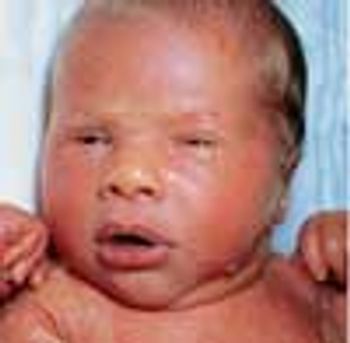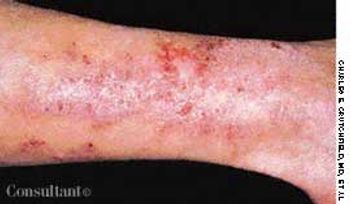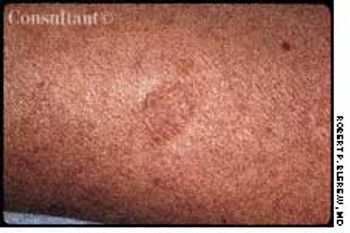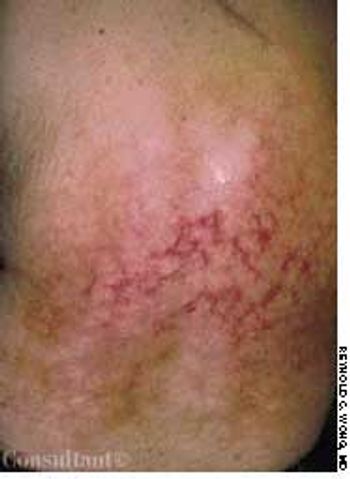
Fibroadenomas are the most common benign solid tumors of breast tissue. They may develop at any time after puberty, but they are found most frequently in women in their 20s and 30s and are more common than cysts among women aged 25 or younger.

Fibroadenomas are the most common benign solid tumors of breast tissue. They may develop at any time after puberty, but they are found most frequently in women in their 20s and 30s and are more common than cysts among women aged 25 or younger.

Asymptomatic facial and truncal papules began developing several years before this 55-year-old man sought medical care. The lesions were slightly yellowish or reddish, and many had a central punctum. Biopsy revealed a microscopic picture consistent with sebaceous adenoma.

A 70-year-old man first noticed this skin condition when he returned from the South Pacific at the end of World War II. Over the years, the rash has itched only occasionally; however, during a recent spate of hot weather, the eruption became highly pruritic. Applications of an over-the-counter 1% hydrocortisone ointment exacerbated the condition.

The coppery hyperpigmentation on the front and sides of a 47-year-old woman's neck, sparing a large area on the anterior surface, had been present for many years. She had no itching, burning, or other symptoms associated with the discoloration. Questioning revealed that she used perfume liberally on her neck and had been a sun worshipper in years past.

When this boy was born, he was covered by a transparent membrane resembling oiled parchment or collodion. The membrane was shed within 2 weeks and, subsequently, the infant was found to have normal skin. Lamellar ichthyosis usually develops in babies with this condition, although in some the skin clears completely.

A 40-year-old farmer had been complaining for 3 weeks of a tender, red, itchy, scaling plaque with papulopustules on one knee. A potassium hydroxide examination of the scale revealed fungal hyphae.

A 40-year-old man presented with tiny, intensely pruritic vesicles on the knees, legs, buttocks, elbows, and scalp.

A 0.5-cm mass with overlying erythema on the forehead of a 5-month-old girl was first noticed after she had been hit on the head with a rattle. Excision of the mass was deferred because it was considered to be a hemangioma.

An 87-year-old man sought treatment of an irritated, red left eye with an enlarging “growth.” Two years earlier, the growth in the eye had been examined by another ophthalmologist. The patient could not recall the diagnosis and stated that no specific therapy had been initiated.

These pruritic but otherwise asymptomatic lesions on the right upper arm of a 77-year-old woman first appeared about 1 year before she sought medical consultation. The patient's history included frequent, generalized pruritus, which was believed to be secondary to long-standing type 1 diabetes mellitus.

A 34-year-old man experienced fever and arthralgia several days after appearance of the rash.

Diabetes mellitus recently had been diagnosed in a 58-year-old woman. The patient claims that her skin had darkened significantly over the past 5 years.

Concern about this flat, tan, atrophic, well-marginated, dime-sized lesion prompted a 44-year-old woman to seek medical advice. The lesion, which was mildly pruritic, had appeared 2 months earlier.

Three months ago, a 50-year-old man who was otherwise in good health noticed a hard, round nodule on his left arm. Within 2 months, similar nodules appeared all over his trunk, head, arms, and legs. The reddish purple lesions, less than 2 cm in diameter, were painless and slightly pruritic.

This truncal lesion was revealed when a 47-year-old man disrobed for examination after he had fallen on a sheet of ice and broken a rib. The patient-a truck driver and 30 pack-year cigarette smoker-had been aware of the enlarging lesion for about a year but had not sought medical attention because it was asymptomatic.

An 85-year-old white woman was brought to the emergency department (ED) with acute, severe left posterolateral chest wall pain of several hours' duration. The nonradiating pain was accompanied by shortness of breath. She denied palpitations, diaphoresis, syncope, or dizziness.

An area of mottled skin developed on the back of a 55-year-old woman who has had arthritis for several years. She often applied a heating pad to her middle and lower back for relief from arthritic pain.

An ulcerating nodule on his left pre-auricular region worried a 64-year-old man.

A 37-year-old man presented with a reddish nodule in the umbilical area that had been present since early infancy. The lesion had been cauterized with silver nitrate several times in the past but had not resolved. No drainage or secondary infection was noted, and the patient was otherwise in good health.

At 3 days of age, this infant was noted to have an erythematous, maculopapular rash on the face, chest, abdomen, and back that included some pustule-like lesions.

In the web space of his left hand, a 50-year-old barber had a painful cystlike lesion. The lesion had recurred intermittently, despite oral antibiotic treatment and warm compresses. The patient's father, also a barber, had a similar, more severe condition, which eventually required surgical intervention.

For 1 month, a 66-year-old man had had an asymptomatic lesion on the dorsum of his left hand. The flesh-colored, dome-shaped, maroon-crusted lesion measured 0.7 cm in diameter and was located over the fourth knuckle. The patient had chronic obstructive pulmonary disease but was otherwise in good health. He was seronegative for HIV.

A 55-year-old woman with no significant medical history reported that diffuse erythematous, patchy, purpuric skin lesions over most of her body had been present for the past year. Applications of an over-the-counter corticosteroid cream helped control the pruritus but did not clear the skin lesions.

During a routine physical examination, a white forelock was noted on a 54-year-old man. The patient stated that the discolored patch of hair had been present since adolescence. Other than mild hearing loss, he had no significant personal or family medical history.

A previously healthy 52-year-old man had been using an antidandruff shampoo and a topical corticosteroid for a chronic scalp eruption that had been diagnosed as seborrheic dermatitis. Because the condition had not responded to this regimen, a scalp biopsy was performed; the findings were consistent with seborrheic dermatitis.